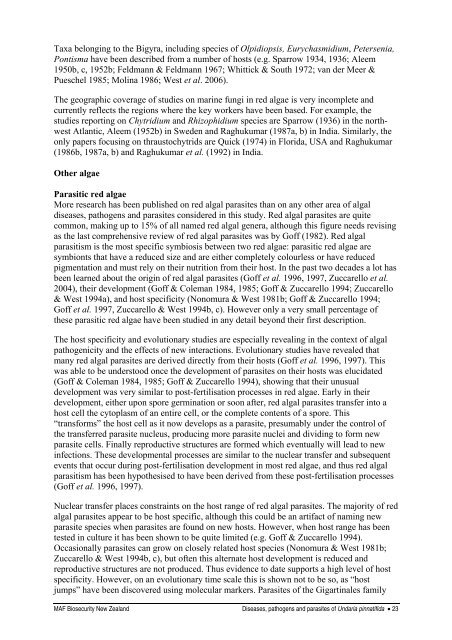Diseases, pathogens and parasites of Undaria pinnatifida
Diseases, pathogens and parasites of Undaria pinnatifida
Diseases, pathogens and parasites of Undaria pinnatifida
Create successful ePaper yourself
Turn your PDF publications into a flip-book with our unique Google optimized e-Paper software.
Taxa belonging to the Bigyra, including species <strong>of</strong> Olpidiopsis, Eurychasmidium, Petersenia,<br />
Pontisma have been described from a number <strong>of</strong> hosts (e.g. Sparrow 1934, 1936; Aleem<br />
1950b, c, 1952b; Feldmann & Feldmann 1967; Whittick & South 1972; van der Meer &<br />
Pueschel 1985; Molina 1986; West et al. 2006).<br />
The geographic coverage <strong>of</strong> studies on marine fungi in red algae is very incomplete <strong>and</strong><br />
currently reflects the regions where the key workers have been based. For example, the<br />
studies reporting on Chytridium <strong>and</strong> Rhizophidium species are Sparrow (1936) in the northwest<br />
Atlantic, Aleem (1952b) in Sweden <strong>and</strong> Raghukumar (1987a, b) in India. Similarly, the<br />
only papers focusing on thraustochytrids are Quick (1974) in Florida, USA <strong>and</strong> Raghukumar<br />
(1986b, 1987a, b) <strong>and</strong> Raghukumar et al. (1992) in India.<br />
Other algae<br />
Parasitic red algae<br />
More research has been published on red algal <strong>parasites</strong> than on any other area <strong>of</strong> algal<br />
diseases, <strong>pathogens</strong> <strong>and</strong> <strong>parasites</strong> considered in this study. Red algal <strong>parasites</strong> are quite<br />
common, making up to 15% <strong>of</strong> all named red algal genera, although this figure needs revising<br />
as the last comprehensive review <strong>of</strong> red algal <strong>parasites</strong> was by G<strong>of</strong>f (1982). Red algal<br />
parasitism is the most specific symbiosis between two red algae: parasitic red algae are<br />
symbionts that have a reduced size <strong>and</strong> are either completely colourless or have reduced<br />
pigmentation <strong>and</strong> must rely on their nutrition from their host. In the past two decades a lot has<br />
been learned about the origin <strong>of</strong> red algal <strong>parasites</strong> (G<strong>of</strong>f et al. 1996, 1997, Zuccarello et al.<br />
2004), their development (G<strong>of</strong>f & Coleman 1984, 1985; G<strong>of</strong>f & Zuccarello 1994; Zuccarello<br />
& West 1994a), <strong>and</strong> host specificity (Nonomura & West 1981b; G<strong>of</strong>f & Zuccarello 1994;<br />
G<strong>of</strong>f et al. 1997, Zuccarello & West 1994b, c). However only a very small percentage <strong>of</strong><br />
these parasitic red algae have been studied in any detail beyond their first description.<br />
The host specificity <strong>and</strong> evolutionary studies are especially revealing in the context <strong>of</strong> algal<br />
pathogenicity <strong>and</strong> the effects <strong>of</strong> new interactions. Evolutionary studies have revealed that<br />
many red algal <strong>parasites</strong> are derived directly from their hosts (G<strong>of</strong>f et al. 1996, 1997). This<br />
was able to be understood once the development <strong>of</strong> <strong>parasites</strong> on their hosts was elucidated<br />
(G<strong>of</strong>f & Coleman 1984, 1985; G<strong>of</strong>f & Zuccarello 1994), showing that their unusual<br />
development was very similar to post-fertilisation processes in red algae. Early in their<br />
development, either upon spore germination or soon after, red algal <strong>parasites</strong> transfer into a<br />
host cell the cytoplasm <strong>of</strong> an entire cell, or the complete contents <strong>of</strong> a spore. This<br />
“transforms” the host cell as it now develops as a parasite, presumably under the control <strong>of</strong><br />
the transferred parasite nucleus, producing more parasite nuclei <strong>and</strong> dividing to form new<br />
parasite cells. Finally reproductive structures are formed which eventually will lead to new<br />
infections. These developmental processes are similar to the nuclear transfer <strong>and</strong> subsequent<br />
events that occur during post-fertilisation development in most red algae, <strong>and</strong> thus red algal<br />
parasitism has been hypothesised to have been derived from these post-fertilisation processes<br />
(G<strong>of</strong>f et al. 1996, 1997).<br />
Nuclear transfer places constraints on the host range <strong>of</strong> red algal <strong>parasites</strong>. The majority <strong>of</strong> red<br />
algal <strong>parasites</strong> appear to be host specific, although this could be an artifact <strong>of</strong> naming new<br />
parasite species when <strong>parasites</strong> are found on new hosts. However, when host range has been<br />
tested in culture it has been shown to be quite limited (e.g. G<strong>of</strong>f & Zuccarello 1994).<br />
Occasionally <strong>parasites</strong> can grow on closely related host species (Nonomura & West 1981b;<br />
Zuccarello & West 1994b, c), but <strong>of</strong>ten this alternate host development is reduced <strong>and</strong><br />
reproductive structures are not produced. Thus evidence to date supports a high level <strong>of</strong> host<br />
specificity. However, on an evolutionary time scale this is shown not to be so, as “host<br />
jumps” have been discovered using molecular markers. Parasites <strong>of</strong> the Gigartinales family<br />
MAF Biosecurity New Zeal<strong>and</strong> <strong>Diseases</strong>, <strong>pathogens</strong> <strong>and</strong> <strong>parasites</strong> <strong>of</strong> <strong>Undaria</strong> <strong>pinnatifida</strong> • 23

















